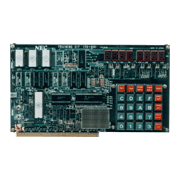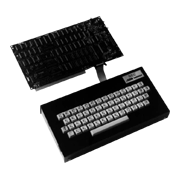In August 1976, NEC marketed the low-cost fully-operational TK-80 assembly kit for hobbyists. This was done to achieve greater dissemination of microcomputers. The TK-80 was equipped with the µ PD8080A (which was compatible with the 8080 8-bit microprocessor from Intel), an LED (Light Emitting Diode) display and a hexadecimal keyboard. The machine enabled creation and execution of programs in machine language. In addition to the assembly manual, the system came with a circuit diagram and a program listing for basic software called a "monitor".
In September of that same year, NEC opened a Bit-INN Service Center on the seventh floor of the Radio Kaikan building in Akihabara to provide technical support to customers.
In November of the following year, NEC marketed the TK-80BS expansion board for the TK-80 kit. This allowed the use of BASIC, and made it possible to connect the system to a household TV receiver for use as a CRT display for output. In this way, the TK-80 recorded sales of about 66,000 units in the two years after it went on sale.




